Scottish Fold
| Scottish Fold | |
|---|---|
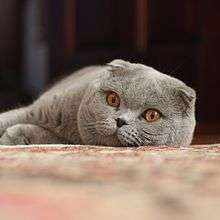 Lilac colored adult Scottish Fold, displaying round face, round eyes and forward-folded ears. | |
| Other names | Scot Fold |
| Origin | Scotland |
| Breed standards | |
| CFA | standard |
| TICA | standard |
| AACE | standard |
| ACFA/CAA | standard |
| Notes | |
| Domestic cat (Felis catus) | |
The Scottish Fold is a breed of domestic cat with a natural dominant-gene mutation that affects cartilage throughout the body, causing the ears to "fold", bending forward and down towards the front of their head, which gives the cat what is often described as an "owl-like" appearance.[1]
Originally called lop-eared or lops after the lop-eared rabbit, Scottish Fold became the breed's name in 1966.[1] Depending on registries, longhaired Scottish Folds are varyingly known as Highland Fold, Scottish Fold Longhair, Longhair Fold and Coupari.[2]
History
Origin
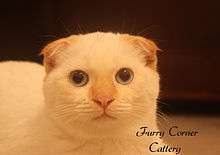
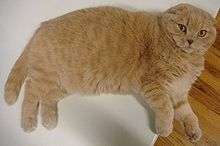
The original Scottish Fold was a white barn cat named Susie, who was found at a farm near Coupar Angus in Perthshire, Scotland, in 1961. Susie's ears had an unusual fold in their middle, making her resemble an owl. When Susie had kittens, two of them were born with folded ears, and one was acquired by William Ross, a neighbouring farmer and cat-fancier. Ross registered the breed with the Governing Council of the Cat Fancy (GCCF) in Great Britain in 1966 and started to breed Scottish Fold kittens with the help of geneticist Pat Turner. The breeding program produced 76 kittens in the first three years—42 with folded ears and 34 with straight ears. The conclusion from this was that the ear mutation is due to a simple dominant gene.[3]
Susie's only reproducing offspring was a female Fold named Snooks who was also white; a second kitten was neutered shortly after birth. Three months after Snooks' birth, Susie was killed by a car. All Scottish Fold cats share a common ancestry to Susie.[2]
Acceptance
The breed was not accepted for showing in Europe and the GCCF withdrew registrations in 1971 due to crippling deformity of the limbs and tail in some cats and concerns about genetic difficulties and ear problems such as infection, mites, and deafness, but the Folds were exported to America and the breed continued to be established using crosses with British Shorthairs and American Shorthairs. Since the initial concerns were brought, the Fold breed has not had the mite and infection problems, though wax buildup in the ears may be greater than in other cats.[1][2]
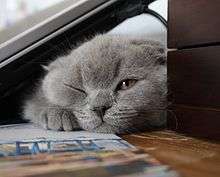
Popularity
The rare distinctive physical traits of the breed, combined with their reputation as unusually loving companions, make Folds highly sought-after pets and Fold kittens typically cost considerably more than kittens of more common breeds.[4]
Characteristics
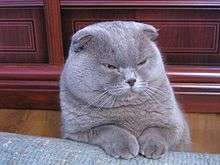
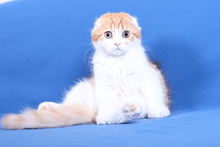
Ears
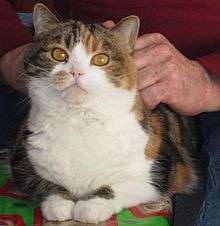
All Folds are born with straight, unfolded ears, and those with the Fold gene will begin to show the fold usually within about 21 days. The kittens that do not develop folded ears are known as Straights.[1] The original cats only had one fold in their ears, but due to selective breeding, breeders have increased the fold to a double or triple crease that causes the ear to lie totally flat against the head.
The breed's distinctive folded ears are produced by an incompletely dominant gene that affects the cartilage of the ears, causing the ears to fold forward and downward, giving a cap-like appearance to the head. Smaller, tightly folded ears set in a cap-like fashion are preferred to a loose fold and larger ear. The large, round eyes and rounded head, cheeks, and whisker pads add to the overall rounded appearance. Despite the folded ears, folds still use their aural appendages to express themselves—the ears swivel to listen, lay back in anger and prick up when the treat bag rustles.[4]
Body
The Scottish Fold is a medium-sized cat, with males typically reaching 4 to 6 kg (9–13 lb), females 2.7–4 kg (6–9 lb). The Fold's entire body structure, especially the head and face, is generally rounded, and the eyes large and round. The nose will be short with a gentle curve and the cat's body well-rounded with a padded look and medium-to-short legs. The head is domed at the top, and the neck very short. The broadly-spaced eyes give the Scottish Fold a "sweet expression".[3]
Coat
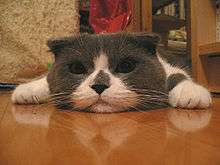
Scottish Folds can be either long- or short-haired, and they may have nearly any coat color or combination of colours (including white)[3]
Temperament
Scottish Folds, whether with folded ears or with normal ears, are typically good-natured and placid and adjust to other animals within a household extremely well. They tend to become very attached to their human caregivers and are by nature quite affectionate. Folds also receive high marks for playfulness, grooming and intelligence.[2] These animals like to be outdoors and enjoy outdoor games and activities very much. Loneliness is something they heavily dislike and which makes them feel depressed.[5] It is also common for Scottish Folds to be stubborn.
Habits
Folds are also known for sleeping on their backs.[3] Scottish Folds typically have soft voices and display a complex repertoire of meows and purrs not found in better-known breeds. Folds are also known for sitting with their legs stretched out and their paws on their belly. This is called the "Buddha Position".[6]
Genetics
An early study suggested that the fold is inherited as an autosomal dominant trait.[7] A later study suggested an incomplete dominance.[8] A cat with folded ears may have either one (heterozygous) or two copies (homozygous) of the fold gene (Fd). A cat with normal ears should have two copies of the normal gene (fd).
|
|
| |||||||||||||||||||||||||||||||||||||||||||||
Mating a homozygous fold with any cat will produce all folds, but because homozygous folds are prone to severe health issues, breeding for them is generally considered unethical. A homozygous to normal mating will produce only heterozygous folds but presumably in ethical breeding programs, there will be no homozygous cats available to breed from.
| Straight-eared | |||
|---|---|---|---|
| fd | fd | ||
| Heterozygous fold | Fd | Fd fd | Fd fd |
| fd | fd fd | fd fd | |
The only generally accepted breeding gives a 50% chance of producing heterozygous folds and 50% chance of producing normals.
| Heterozygous fold | |||
|---|---|---|---|
| Fd | fd | ||
| Heterozygous fold | Fd | Fd Fd | Fd fd |
| fd | fd Fd | fd fd | |
There is suspicion that some non-fold litters are genetically heterozygous folds but because of very low expression of the gene, appear to be straight-eared. Such kittens may develop folded ears initially which then straighten back out. Because of this there are suggestions by some breeders to avoid mating Folds with straight-eared Scottish Folds but only use British Shorthairs (BSH) as outcross.[9][10] If Scottish Shorthairs are to be used, they should be test mated to a BSH to make sure that they are not genetically folds.[9] If such apparent straight-eared cats are mated with a fold, there is a 75% chance of folds(25% homozygous folds, 50% heterozygous folds) and 25% chance of straight ears.
Health
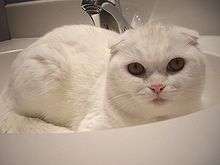
The typical lifespan of a Scottish Fold is 15 years.[3]
Scottish folds are susceptible to polycystic kidney disease (PKD)[11] and cardiomyopathy.[12]
Osteochondrodysplasia
Osteochondrodysplasia (OCD) is a developmental abnormality that affects cartilage and bone development throughout the body. This condition causes the fold in the breed and in studies conducted so far, all folded cats are affected by it.[13] Homozygous folds are affected by malformed bone structures and develop severe painful degenerative joint diseases at an early age. This condition also affects heterozygous folds, but usually to a much lesser extent and at a later age. Some will be asymptomatic.
While ethical breeders breed Fold/non-fold and not Fold/Fold (in the same way Munchkins are bred) to avoid producing homozygous folds,[3] because heterozygous folds can also develop progressive arthritis of varying severity, some researchers recommend abandoning the breeding of folded cats entirely.[7][14] For this reason the breed is not accepted by either the Governing Council of the Cat Fancy[15] or the Fédération Internationale Féline.[16]
CFA breeders have stated that using only fold to non-fold breeding has eliminated problems with stiff tails, shortened tails and bone lesions.[1] In the FIFe discussion, the representative for British breeders claimed that they were not seeing the problem in their cats and that the study which showed that all heterozygous also have the condition had a small sample size. An offer of free X-rays was presented to 300 breeders to find a folded cat with healthy hind legs but it was never taken up.[17][18] A similar offer was set up by the World Cat Federation together with researcher Leslie Lyons but there was also no response. FiFe stated that they will not consider recognizing Scottish Folds if breeders will not allow their breed to be scrutinized.[19]
In a report on Scottish Folds, the Breed Standards Advisory Council (BSAC) for New Zealand Cat Fancy (NZCF) states that "Breeders may not have appreciated the strength of the evidence that heterozygous cats can and do develop [feline] OCD." While research shows that all heterozygous folds develop OCD, and anecdotal evidence shows that heterozygous folds can and do develop OCD, they do not show whether mildly affected parents are more likely to have mildly affected offspring. They also do not show what percentage of Folds are severely affected. The report states that there is not enough information to justify banning Scottish Fold matings but enough to justify a level of concern.[9] Recommended guidelines includes:
- A requirement for periodic vet examination of breeding cats for any evidence of lameness, stiffness, or pain - breeding cats with signs to be desexed
- A requirement for periodic x-rays of breeding cats and comparison of x-ray evidence with clinical symptoms, possibly leading to a requirement that cats with a specified degree of skeletal change to be desexed.
- Requesting the agreement of pet owners to be periodically contacted by the NZCF or by a researcher, to provide reports about the health of their cat
- All information to be reported /submitted to the BSAC to allow information about to be collated to give an overall picture of FOCD in Scottish Folds in NZ.
- Requirements to be in place for a minimum of 5 years to enable tracking of the health of Folds over time.
In literature and entertainment
Biography
- The Scottish Fold is featured in-depth in the short novel The Cat Who Went to Paris by Peter Gethers.[1][20] The book and its two sequels, A Cat Abroad and The Cat Who'll Live Forever: The Final Adventures of Norton, the Perfect Cat, and His Imperfect Human, document the life of Gethers and his Fold, Norton, from their first meeting to Norton's eventual death and Gethers' experiences after the loss.[20][21][22]
In popular culture
- In the 2012 novel The Bone Bed, Kay Scarpetta rescues a Scottish Fold cat from a murder victim's home. She brings her home to meet the greyhound rescued in an earlier novel. They apparently get along well.
- In the Anime series Beyond the Boundary, the Youmu form of the Anime-exclusive character Ai Shindō is a two-tailed Scottish Fold cat. Also, in Durarara!!x2, Kasuka "Yuuhei" Heiwajima has a pet Scottish fold kitten named Yuigadokusonmaru. In another series, "Hetalia", the character England's cat counterpart is a Scottish Fold.
- In the Disney/Square Enix crossover franchise of Kingdom Hearts, a Dream Eater creature known as Chirithy is a key character in Kingdom Hearts χ. The design of the creature is inspired by a Scottish Fold.[23]
- The manga series Free Collars Kingdom contains a female character named Scottie, who is based on the Scottish Fold cat.
Internet media
- In 2009, Maru, a Scottish Fold cat, became an Internet sensation due to his obsession with boxes. Several commercials have been produced featuring the cat. A YouTube account featuring videos of Maru has almost half a million subscribers.[24]
- Waffles is the name of a Scottish Fold cat, featured on the Facebook page "Waffles The Cat". The page has 2,453,572 likes as of May 2016.
- A Scottish Fold called Shrampton and his sister Bunni have over 40,000 instagram followers.[25]
- A Scottish Fold named Dr. Meemersworth often appears in the videos of its owner, Simon and Martina Stawski from Eat Your Kimchi.[26]
See also
- American Curl, a breed with ears curving up and back, somewhat opposite to the Scottish Fold
- Cat body type genetic mutations
- List of Scottish breeds
- Maru (cat)
References
- 1 2 3 4 5 6 Grace Sutton (1999-05-31). "Breed article: Scottish Folds". Cat Fanciers' Association. Retrieved 2012-01-29.
- 1 2 3 4 J. Anne Helgren. "Petfinder "Scottish Fold"". Petfinder.com. Retrieved 2009-10-03.
- 1 2 3 4 5 6 "Scottish Fold FAQ". Fanciers.com. 1971-11-30. Retrieved 2009-10-03.
- 1 2 J. Anne Helgren. "Choosing a Scottish Fold". Pet Place. Retrieved 2009-10-03.
- ↑ Stephenson, Brian. "Scottish fold temperament and personality". scottishfoldlove.com. Retrieved 21 October 2014.
- ↑ "Scottish Fold". breedlist.com.
- 1 2 Malik, R.; Allan, G.S.; Howlett, C.R.; Thompson, D.E.; James, G.; McWhirter, C.; Kendall, K. (Feb 1999). "Osteochondrodysplasia in Scottish Fold cats". Aust. Vet. J. 77 (2). pp. 85–92. PMID 10078353.
- ↑ "Incomplete dominant osteochondrodysplasia in heterozygous Scottish Fold cats.". The Journal of small animal practice. 2008.
- 1 2 3 "Minutes of Executive Council Meeting No: 28 (doc)". New Zealand Cat Fancy. 24–25 September 2011. Retrieved 3 February 2012.
- ↑ Sutton, Grace. "Breed Article: Scottish Folds". The Cat Fanciers’ Association. Retrieved 7 December 2013.
- ↑ Shirley Little. "Polycystic Kidney Disease (PKD)". Scottishfold.org. Retrieved 2009-10-03.
- ↑ Shirley Little. "Cardiomyopathy". Scottishfold.org. Retrieved 2009-10-03.
- ↑ "Genetic welfare problems of companion animals: Scottish Fold: Osteochondrodysplasia". Universities Federation for Animal Welfare. 2011. Retrieved 2 February 2012.
- ↑ Malik, Richard (2003). "Genetic Disorders of Cats". World Small Animal Veterinary Association World Congress Proceedings, 2003. Retrieved 20 December 2009.
- ↑ "The GCCF says Health Comes First", The Governing Council of the Cat Fancy
- ↑ "Breeding and Registration Rules (date of issue: 01.01.2008)" — as described in §2.7.3 "Genetic Diseases", Fédération Internationale Feline
- ↑ "FIFe decision not to accept Scottish Fold breed in May 2003". Retrieved 2 February 2012.
- ↑ "Email from ScottishFoldandScottishShorthairGroup". 2008. Retrieved 2 February 2012.
- ↑ "Minutes of the Business Meeting of the World Cat Congress: Arnhem, the Netherlands: 14th April. 2009". Retrieved 2 February 2012.
- 1 2 Peter Gethers. The Cat Who Went to Paris. ISBN 978-0-449-90763-4.
- ↑ Peter Gethers. A Cat Abroad. ISBN 978-0-449-90952-2.
- ↑ Peter Gethers. The Cat Who'll Live Forever. ISBN 978-0-7679-0903-7.
- ↑ "Kingdom Hearts χ and Kingdom Hearts III - Chirithy inspiration and more...". June 2015.
- ↑ "Mugumogu". YouTube. Retrieved 6 September 2016.
- ↑ "Shrampton (@shrampton)". instagram.com.
- ↑ "Introducing: Dr Meemersworth - Our New Scottish Fold Kitten". youtube.com. 20 July 2012. Retrieved 12 September 2016.
External links
| Wikimedia Commons has media related to Scottish Fold. |